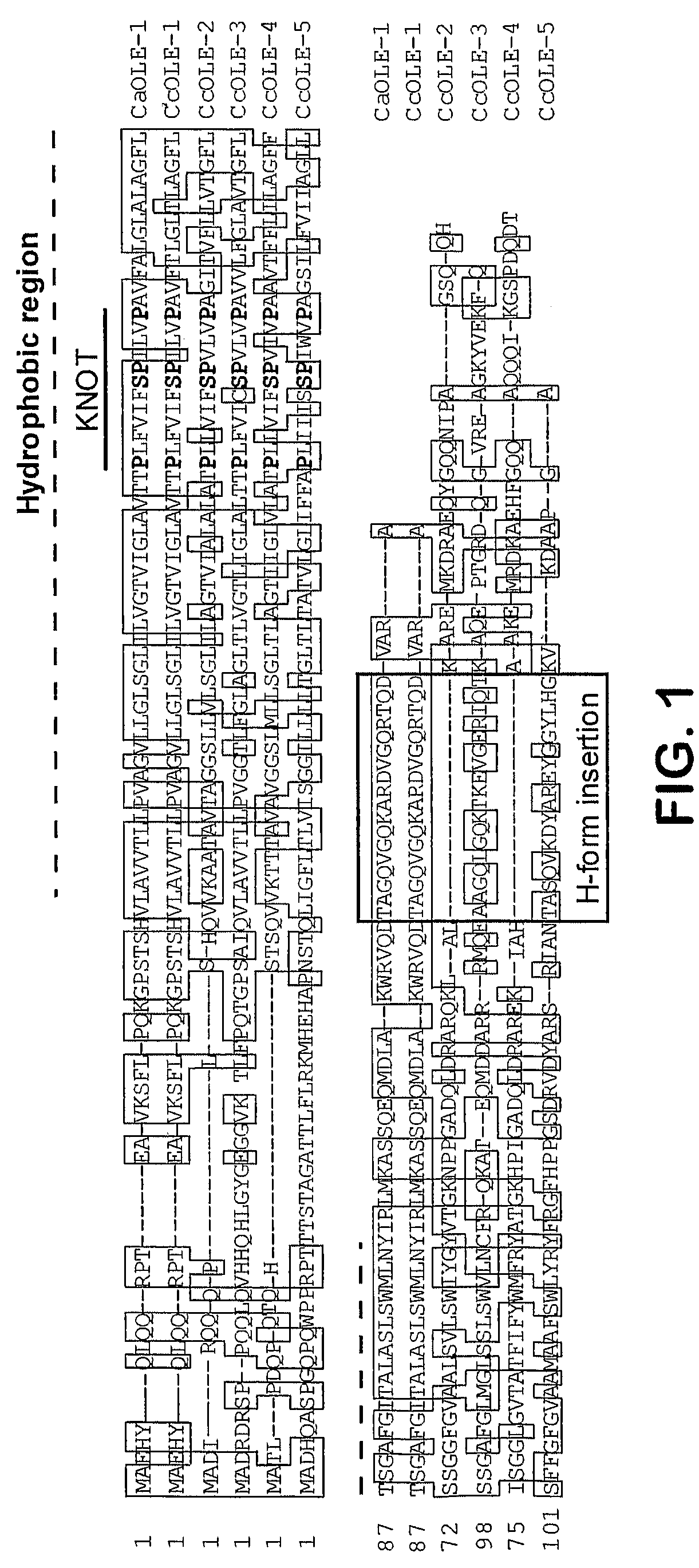Oleosin genes and promoters from coffee
a technology of oleosin and promoters, which is applied in the field of oleosin genes and promoters from coffee, can solve the problems of lack of scientific data regarding the number of such data, and achieve the effects of increasing the expression of one or more endogenous oleosins, modulating the flavor or aroma of coffee beans, and increasing the production of one or more oleosins
- Summary
- Abstract
- Description
- Claims
- Application Information
AI Technical Summary
Benefits of technology
Problems solved by technology
Method used
Image
Examples
example 1
Plant Material for RNA Extraction
[0124]Freshly harvested roots, young leaves, stems, flowers and fruit at different stages of development were harvested from Coffea arabica L. cv. Catturra T-2308 grown under greenhouse conditions (25° C., 70% RH) and from Coffea canephora (robusta) BP-409 grown in the field in Indonesia. The development stages are defined as follows: small green fruit (SG), large green fruit (LG), yellow fruit (Y) and red fruit (R). Fresh tissues were frozen immediately in liquid nitrogen, then stored at −80° C. until used for RNA extraction.
example 2
Extraction of Total RNA and Generation of cDNA
[0125]Samples stored at −80° C. were ground into a powder and total RNA was extracted from this powder using the method described by Gilloteau et al., 2003. Samples were treated with DNase using the kit “Qiagen RNase-Free DNase” according to the manufacturer's instructions to remove DNA contamination. All RNA samples were analysed by formaldehyde agarose gel electrophoresis and visual inspection of the ribosomal RNA bands upon ethidium bromide staining. Using oligo (dT20) as a primer, cDNA was prepared from approximately 4 μg total RNA according to the protocol in the Superscript II Reverse Transcriptase kit (Invitrogen, Carlsbad, Calif.). To test for the presence of contaminating genomic DNA in the cDNA preparations, a primer pair was designed spanning a known intron of a specific ubiquitously expressed cDNA, chalcone isomerase (CHI). RT-PCR was carried out using 10-fold dilution of cDNA corresponding to 0.1 μg of original RNA. Conventi...
example 3
Promoter Isolation and Vector Construction
[0128]The 5′ upstream region of OLE-1 from Coffea canephora was recovered using the Genewalker kit (BD Biosciences) and the primers OLE-IA (5′-AAGTTGATGGACCCTTCTGAGGAAGG-3′) (SEQ ID NO.:55) followed by nested PCR using primer OLE-1B (5′-AGCTGGTAGTGCTCAGCCATGAAGG-3′) (SEQ ID NO.:56). PCR reactions contained 1× buffer and 5 mM MgCl2, 200 μM each of dATP, dCTP, dGTP and dTTP, and 1 unit of LA Taq polymerase (Takara, Combrex Bio, Belgium) with 200 nM primer OLE-1A and 200 nM primer AP1 (Genewalker kit). The reaction mixture was incubated for 10 min at 94° C., followed by 7 amplification cycles of 25 sec at 94° C. / 4 min at 72° C. and then 32 amplification cycles of 25 sec at 94° C. / 4 min at 67° C. The PCR reaction was diluted 1 / 200 and the used for a second PCR reaction using 200 nM of nested primer OLE-LB and 200 nM of nested primer AP2. Nested PCR was incubated for 10 min at 94° C., followed by 5 amplification cycles of 25 sec at 94° C. / 4 min a...
PUM
| Property | Measurement | Unit |
|---|---|---|
| molecular weight | aaaaa | aaaaa |
| molecular weight | aaaaa | aaaaa |
| molecular weights | aaaaa | aaaaa |
Abstract
Description
Claims
Application Information
 Login to View More
Login to View More - R&D
- Intellectual Property
- Life Sciences
- Materials
- Tech Scout
- Unparalleled Data Quality
- Higher Quality Content
- 60% Fewer Hallucinations
Browse by: Latest US Patents, China's latest patents, Technical Efficacy Thesaurus, Application Domain, Technology Topic, Popular Technical Reports.
© 2025 PatSnap. All rights reserved.Legal|Privacy policy|Modern Slavery Act Transparency Statement|Sitemap|About US| Contact US: help@patsnap.com



